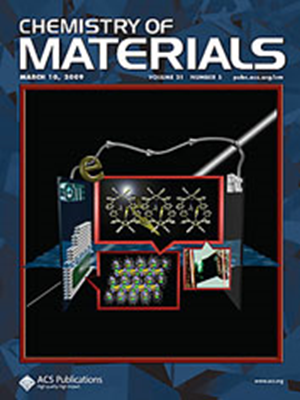基于磷光的凝胶化动态配位驱动组装可视化
IF 7
2区 材料科学
Q2 CHEMISTRY, PHYSICAL
引用次数: 0
摘要
配位驱动的超分子水凝胶具有出色的可加工性和动态责任性,因此在生物医学光子学等应用领域颇具吸引力。由于它们是通过分层组装构建的,凝胶化过程难以高效控制,导致透明度有限。要形成水凝胶,必须逐步引入水以实现凝胶化。可以利用对 H2O 具有高灵敏度的磷光技术对凝胶化过程进行现场监测和精确了解。本文选择了一种由 Gd3+- 腺苷单磷酸(AMP)组装而成的水凝胶作为模型,这种水凝胶是通过 A 碱的强 Gd3+-PO3 配位和 π-π 堆积形成的。在 Gd3+-AMP 矩阵具有良好的客体包涵性和磷光诱导性的基础上,硫黄素-T(ThT,青色荧光)和铂(II)介-四(4-羧基苯基)卟吩(PtTCPP,红色磷光)被共包覆为探针。通过发光变化可观察到凝胶化过程,并确定了两种浑浊的副产物(NPs 和溶胶,肉眼无法区分)。通过对上述浑浊副产物进行进一步的量热研究,可以通过改变合成温度来提高水凝胶的透明度。所获得的柔性透明室温磷光(RTP)水凝胶被探索用于基于光波导的植入式氧传感。本文章由计算机程序翻译,如有差异,请以英文原文为准。

Phosphorescence-Based Visualization of the Dynamic Coordination-Driven Assembly in Gelation
Coordination-driven supramolecular hydrogels feature excellent processability and dynamic responsibility and thus are appealing for applications such as biomedical photonics. Since they are constructed via hierarchical assembly, the gelation processes are difficult to control in a highly efficient manner, leading to limited transparency. For the formation of hydrogel, stepwise introduction of water is essential for the gelation. Phosphorescence with high H2O sensitivity can be explored for in situ monitoring and precise understanding of the gelation process. Herein, a hydrogel from Gd3+-adenosine monophosphate (AMP) assembly was chosen as the model, which was formed via the strong Gd3+-PO3 coordination and π–π stacking of A bases. On the basis of the excellent guest inclusion and phosphorescence inducing of the Gd3+-AMP matrix, thioflavin-T (ThT, cyan fluorescence) and Pt(II) meso-tetra(4-carboxyphenyl) porphine (PtTCPP, red phosphorescence) were coencapsulated as the probe. Via the luminescence changes, the gelation process was visualized, and two kinds of cloudy side products (NPs and sol, indistinguishable to the naked eye) were identified. Further calorimetric investigation on the above cloudy side products allowed for improvement of the transparency of the hydrogel by changing the synthesis temperature. The obtained flexible and transparent room-temperature phosphorescence (RTP) hydrogel was explored for implantable optical waveguide-based oxygen sensing.
求助全文
通过发布文献求助,成功后即可免费获取论文全文。
去求助
来源期刊

Chemistry of Materials
工程技术-材料科学:综合
CiteScore
14.10
自引率
5.80%
发文量
929
审稿时长
1.5 months
期刊介绍:
The journal Chemistry of Materials focuses on publishing original research at the intersection of materials science and chemistry. The studies published in the journal involve chemistry as a prominent component and explore topics such as the design, synthesis, characterization, processing, understanding, and application of functional or potentially functional materials. The journal covers various areas of interest, including inorganic and organic solid-state chemistry, nanomaterials, biomaterials, thin films and polymers, and composite/hybrid materials. The journal particularly seeks papers that highlight the creation or development of innovative materials with novel optical, electrical, magnetic, catalytic, or mechanical properties. It is essential that manuscripts on these topics have a primary focus on the chemistry of materials and represent a significant advancement compared to prior research. Before external reviews are sought, submitted manuscripts undergo a review process by a minimum of two editors to ensure their appropriateness for the journal and the presence of sufficient evidence of a significant advance that will be of broad interest to the materials chemistry community.
 求助内容:
求助内容: 应助结果提醒方式:
应助结果提醒方式:


